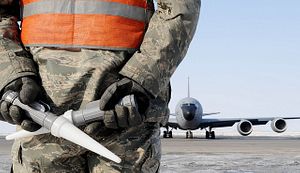Earlier in October, the U.S. Department of Defense announced its intent to transfer the Transit Center at Manas (TCM) International Airport in Kyrgyzstan to the Government of Kyrgyzstan by July 2014. Normally, any such high-level action regarding a military base would raise eyebrows across the United States, but the move went unnoticed by most. Central Asia, after all, hasn’t been the United States’ main strategic theater.
In a feature for The Diplomat, I discussed China’s pivot to Central Asia, guided by a healthy balance of strategic vision and geopolitical savvy. The U.S., on the contrary, has decided that Central Asia simply isn’t worth the trouble. The transfer of TCM is but a symptom of this broader trend. The nexus of U.S. Central Asia policy has been driven by its entrenchment in Afghanistan since 2001. With withdrawal on the horizon in 2014, the U.S. faces a critical choice regarding its involvement in Central Asia.
Earlier this year, the Center for Strategic & International Studies (CSIS) published an excellent report highlighting the prospects and challenges for the United States in Central Asia entitled “The United States and Central Asia after 2014.” Jeffrey Mankoff, the report’s author, acknowledges the hard truths about the region’s strategic relevance to the U.S. but nonetheless argues for engagement. He argues that it is precisely because the U.S. is in no state to exert hard-power hegemony in the region that it can moderate domestic political fault lines through its diplomacy. Mankoff’s argument is nuanced and acknowledges that the Central Asian strategic space can incorporate Russia, China, and the U.S. without any struggle for primacy. Russia and China maintain their relationship with the region for different reasons than the U.S. might. Certain indigenous commentators from Central Asia have made similar arguments for continued U.S. engagement.
To be fair, Central Asia wasn’t always solely seen through the lens of Afghanistan. Joshua Kucera, writing for the New York Times today, notes the United States’ foray into the region in the late 1990s, when it attempted to break the Russian monopoly on the region’s natural gas supply by pushing for a pipeline from the Caspian, through Georgia and Turkey. That kind of thinking towards Central Asia is no more; it was a casualty of the Bush administration’s post-9/11 approach to Afghanistan, and is currently moderated by the geopolitical realities of U.S. energy needs, and increasing self-sufficiency at home.
However, U.S. policy towards Central Asia has been heavily Afghanistan-ized – it sees its strategic engagement with the region largely through the lens of security cooperation during the war. With withdrawal, the United States must conceptualize Central Asia as a region in itself. There are, however, good reasons for ramping down U.S. involvement in the region. The most obvious one is that in a time of constrained defense-spending and an American public that is increasingly weary of foreign entrenchments, it is difficult to see how Central Asia can factor into U.S. policymaking as a priority.
The U.S. may shy away from Central Asia for another reason: China. On one hand, Central Asia is increasingly proving to be a playground for Chinese and Russian strategic interests. The region’s post-Soviet experience and increasing symbiosis with China around land-based energy transfer make any sort of U.S. strategic pitch a hard sell. Geography is cruel to the United States in Central Asia as well. Beyond air power – which the closure of TCM does not do anything to help – the U.S. is effectively neutered in its access to the heavily land-locked region. Iran and Russia – no great friends to the U.S. – buttress access from the North and South. Furthermore, U.S. diplomats would have a much harder time convincing China that the Asian Pivot is not in fact a mode of encirclement if Central Asia were to become a disproportionate focus of U.S. strategic energy.
Mankoff writes that if Washington wants Central Asians to “buy into its vision of the future, [it] needs to reassure them that the Afghanistan it leaves behind is on a stable, sustainable path to the future – or at the very least that it is not an entirely lost cause.” This is another possible determinant of Washington’s ultimate position in the region. Ultimately, while the status in which the U.S. leaves Afghanistan is important, there are other options to continue the Central Asian experiment.
The U.S. could engage Central Asian states diplomatically, and maintain its aid presence there. In Kyrgyzstan’s case, this resulted in a transition to parliamentary democracy – a transition that ironically empowered the country to request a transfer for the TCM. However, it takes two to tango and Central Asian states may be hesitant to work with the United States. In the International Republican Institute's (IRI) survey of Kyrgyz public opinion, 96 percent of respondents considered Russia to be a partner while only eight percent said the same of the United States. On the contrary, while less than one percent perceived Russia to be a threat, 42 percent saw the United States as one.
How then is U.S. supposed to make strategic inroads in Central Asia? Washington can’t seem to separate its vision for the region from either Afghanistan, or Russia and China, and as a consequence wants to push it lower down the U.S. agenda. The region seems to be skeptical of what the U.S. can offer it in light of its perceptions of the U.S. experience in Afghanistan. China and Russia seem to be overwhelmingly successful in courting regional leaders. If U.S. strategic thinkers are to believe Zbigniew Brzezinski, that Central Asia is pivotal to the grand Eurasian chessboard, then the region demands urgent attention. Current trends indicate, however, that Central Asia is unlikely to see any sort of serious U.S. attention in the near future.
Ankit Panda is Associate Editor of The Diplomat. Follow him on Twitter at @nktpnd.

































